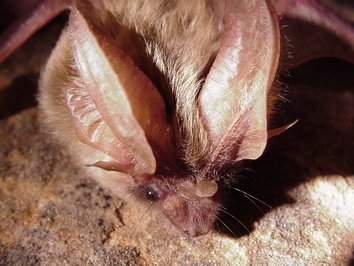Allen’s Big-Eared Bat: Idionycteris Phyllotis

One of the most poorly documented bat species in North America is Allen’s big-eared bat, Idionycteris phyllotis. It was not discovered until 1955 in the United States.
Preferred habitats for the species include rocky and riparian areas in forest and scrubland regions. Nothing is known about the species’ breeding behavior, but in late spring and early summer, females were found with single young people.
The species is nocturnal, roosting in caves or rock crevices during the day and hunting at night. Allen’s big-eared bat is an insectivore, eating insects caught in flight or plucked from vegetation. 1Go To Source dwrcdc.nr.utah.gov -“ALLEN’S BIG-EARED BAT”
Learn more: List Of Bat Species
Allen’s Big-Eared Bat Physical Characteristics
Idionycteris phyllotis, known as Allen’s Big-Eared Bat, is distinguishable by its large ears (34 to 43 mm) that have lappets extending over the forehead from the base of the ears.
The total length of Idionycteris phyllotis is 103 to 118 mm, with a tail length of 44 to 55 mm and a forearm length of 42 to 49 mm. Allen’s big-eared bat’s wingspan ranges from 302 to 344 mm.
The dorsal and ventral pelage, with yellowish-gray tips, is long (10mm) and sometimes black. At the base of the ears, a patch of white hair is developed. In general, females are around 5% greater in head and body length, but there is no difference in the forearm’s length. 2Go To Source animaldiversity.org -“Idionycteris phyllotis Allen’s big-eared bat”
Habitat Of The Allen Big-Eared Bat
This bat is known to roost in abandoned mine shafts in Arizona, most frequently in ponderosa pine, Mexican pinyon-juniper forest, and sycamore, cottonwood, and willow riparian areas. Near boulder piles, cliffs, rocky outcroppings, or lava flows, this species is frequently found.
Big-Eared Bat Range
The bat is found in elevations from 2,600 to 9,800 feet, but most Allen big-eared bats are found between 3,500 and 7,500 feet. It is understood that Allen’s big-eared bats range from Arizona’s Colorado River Valley to New Mexico and Mexico’s central highlands.
This species is best known for occurring along the Mogollon Rim and neighboring mountain ranges in Arizona. In the following counties, records of events exist Mohave, Coconino, Yavapai, Gila, Graham, and Cochise. 3Go To Source pima.gov -“Allen’s Big-eared Bat Idionycteris phyllotis”
Allen’s Big-Eared Bat Reproduction
Not much is known about the reproductive ecology of the Allen large-eared bat. Females segregate from males in the spring to form maternity colonies. They ranged in size from 25-97 individuals from the few maternity colonies known and were in mine tunnels or a pile of rubble near a grotto. Females usually have 1 young person by mid-summer who is traveling. 4Go To Sources cnhp.colostate.edu -“Allen’s big-eared bat (Idionycteris phyllotis)”
Sources:
- “ALLEN’S BIG-EARED BAT.” Utah DNR, dwrcdc.nr.utah.gov/rsgis2/Search/Display.asp?FlNm=idiophyl. Accessed 10 Dec. 2020.
- Alvarado, D. 2000. “Idionycteris phyllotis” (On-line), Animal Diversity Web. Accessed December 10, 2020 at https://animaldiversity.org/accounts/Idionycteris_phyllotis/
- “Allen’s Big-Eared Bat.” Pima County Arizona, www.pima.gov/CMO/SDCP/species/fsheets/vuln/abeb.html. Accessed 10 Dec. 2020.
- Colorado State University. “SpeciesProfile.” Colorado Bat Working Group, cnhp.colostate.edu/cbwg/bat-list/speciesprofile/?speciesID=19. Accessed 10 Dec. 2020.
